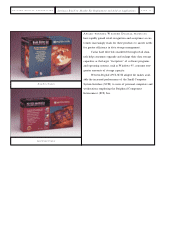Western Digital 1995 Annual Report Download - page 21
Download and view the complete annual report
Please find page 21 of the 1995 Western Digital annual report below. You can navigate through the pages in the report by either clicking on the pages listed below, or by using the keyword search tool below to find specific information within the annual report.
Notes to Consolidated Financial Statements .
N 1 ‒S A P
Western Digital Corporation (“Western Digital” or the “Company”) has prepared
its financial statements in accordance with generally accepted accounting principles
and has adopted accounting policies and practices which are generally accepted in
the industry in which it operates. Following are the Company’s significant account-
ing policies:
Fiscal Year
Effective July 1, 1994, the Company changed its fiscal year end from June 30 to a
52 or 53-week year ending on the Saturday nearest June 30. Accordingly, the 1995
fiscal year ended on July 1, whereas the previous two fiscal years ended on June 30.
All general references to years relate to fiscal years unless otherwise noted.
Basis of Presentation
The consolidated financial statements include the accounts of the Company and
all of its wholly-owned subsidiaries. All significant intercompany accounts and
transactions have been eliminated in consolidation. The accounts of foreign sub-
sidiaries have been translated using the U.S. dollar as the functional currency. As
such, foreign exchange gains or losses resulting from remeasurement of these
accounts are reflected in the results of operations. Monetary and non-monetary
asset and liability accounts have been translated at the exchange rate in effect at
each year end and at historical rates, respectively. Operating statement accounts
have been translated at average monthly exchange rates.
Cash Equivalents and Short-Term Investments
The Company’s cash equivalents represent highly liquid investments, primarily
money market funds and commercial paper, with original maturities of three
months or less. Short-term investments represent investments in U. S. Treasury
Bills with original maturities beyond three months and less than twelve months.
These investments are considered held to maturity and valued at amortized cost,
which approximates fair market value.
Concentration of Credit Risk
The Company designs, manufactures and sells hard drives and microcomputer
products to personal computer manufacturers and resellers throughout the world.
The Company performs ongoing credit evaluations of its customers’financial con-
dition and generally requires no collateral. The Company maintains reserves for
potential credit losses, and such losses have historically been within management’s
expectations. The Company also has cash equivalent and short-term investment
policies that limit the amount of credit exposure to any one financial institution or
investment instrument and restrict placement of these investments with financial
institutions or investment instruments evaluated as highly credit-worthy.
Inventory Valuation
Inventories are valued at the lower of cost or net realizable value. Cost is on a
first-in, first-out basis for raw materials and is computed on a currently adjusted
standard basis (which approximates first-in, first-out) for work in process and
finished goods.
























